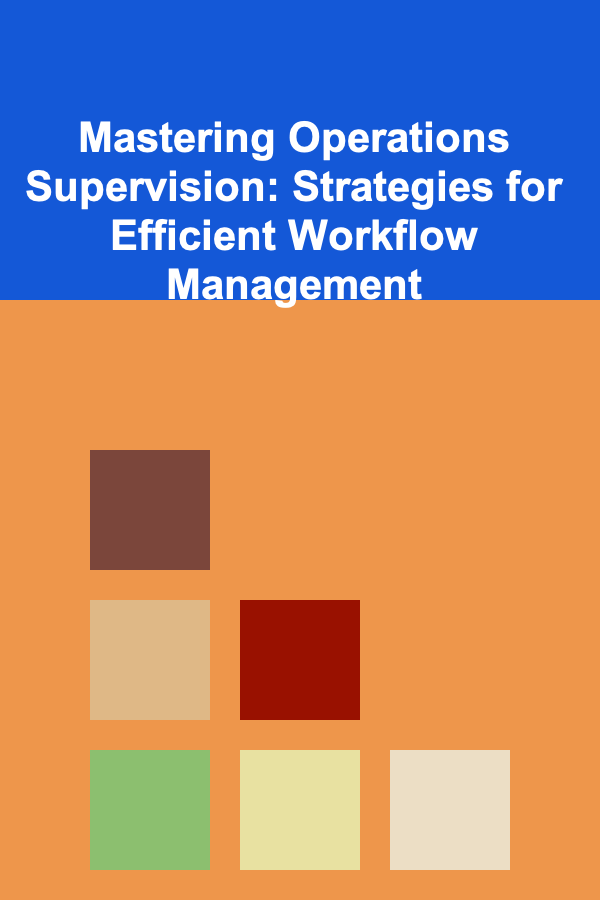
Mastering Operations Supervision: Strategies for Efficient Workflow Management
ebook include PDF & Audio bundle (Micro Guide)
$12.99$7.99
Limited Time Offer! Order within the next:

Effective operations supervision is the backbone of any organization's productivity. It's not enough to simply manage the flow of work; supervisors must be adept at ensuring that processes are streamlined, that resources are allocated effectively, and that teams are motivated and accountable. Achieving efficiency in workflow management requires a combination of leadership skills, strategic planning, and continuous monitoring of operations. This guide will delve into actionable strategies that Operations Supervisors can employ to master workflow management and ensure optimal productivity.
Defining Workflow and Its Importance in Operations
Before diving into strategies, it's crucial to understand what a workflow is and why it matters. A workflow is a sequence of tasks, steps, or processes through which work is carried out from start to finish. It involves the flow of information, tasks, or materials within a system and is critical for any operation aiming to maximize efficiency and minimize errors. Effective workflow management allows an organization to:
- Reduce Time Wastage: By optimizing processes, supervisors can ensure that time is spent on value-adding activities.
- Enhance Communication: Streamlined workflows foster better communication among team members.
- Minimize Errors and Redundancy: Clearly defined workflows prevent mistakes and ensure consistency in operations.
- Increase Productivity: Well-managed workflows enhance the overall output of a team, department, or organization.
As an Operations Supervisor, understanding these principles is the first step in making informed decisions to improve workflow efficiency.
Analyzing and Mapping Existing Workflows
Effective workflow management begins with an understanding of your current processes. Without a clear view of how work flows, it's nearly impossible to improve or streamline it. This is where analyzing and mapping your existing workflows comes in.
Actionable Steps:
- Conduct Workflow Audits: Regularly assess your team's workflows to identify inefficiencies, bottlenecks, and areas where errors are occurring.
- Use Flowcharting Tools: Visual representations, like flowcharts or process maps, can help break down workflows step by step, making it easier to identify where processes can be improved.
- Collaborate with Team Members: Involve the team in this process. They often have invaluable insights into the day-to-day operations and can identify pain points that may not be immediately apparent to supervisors.
By thoroughly understanding how tasks move through your team or department, you can pinpoint areas of improvement and lay the groundwork for a more efficient workflow system.
Setting Clear Objectives and Priorities
Once the current workflow has been mapped out, the next step is to set clear goals and priorities. Without these, teams may struggle to stay focused, and efficiency can suffer.
Actionable Steps:
- Establish SMART Goals: Ensure that objectives are Specific, Measurable, Achievable, Relevant, and Time-bound. For example, rather than a vague goal like "improve productivity," a SMART goal would be "Increase production output by 10% within the next quarter."
- Align Team Goals with Organizational Objectives: Make sure that the goals you set for your team align with broader organizational objectives. This ensures that everyone is working toward a common purpose.
- Prioritize Critical Tasks: Not all tasks hold equal weight in terms of their impact on overall productivity. Prioritize tasks based on their importance to the organization's goals and their effect on the overall workflow.
By setting clear objectives and priorities, you provide your team with direction and focus, reducing the likelihood of wasted effort on non-essential tasks.
Leveraging Technology for Automation
In today's digital age, automation has become a powerful tool in streamlining workflows. As an Operations Supervisor, it's essential to identify processes that can be automated to save time and reduce human error.
Actionable Steps:
- Identify Repetitive Tasks: Look for tasks that are time-consuming and repetitive, such as data entry, inventory tracking, or scheduling. These are prime candidates for automation.
- Implement Workflow Automation Tools: Invest in tools and software that can automate mundane tasks. For example, project management tools like Asana or Trello can automatically assign tasks, set deadlines, and track progress, while inventory management software can automatically update stock levels and order new supplies when necessary.
- Train Your Team: Once automation tools are in place, train your team to use them effectively. This will ensure that the transition to automated workflows is seamless and efficient.
Automation not only boosts productivity but also frees up employees to focus on higher-level tasks that require creativity, problem-solving, and strategic thinking.
Streamlining Communication Channels
Clear communication is one of the most critical aspects of effective workflow management. Without proper communication, even the best workflows can fall apart. As an Operations Supervisor, you should ensure that communication within your team and across departments is as efficient as the workflows themselves.
Actionable Steps:
- Use Centralized Communication Platforms: Tools like Slack, Microsoft Teams, or Basecamp can centralize team communication and ensure that everyone is on the same page.
- Standardize Communication Practices: Develop clear guidelines on how to communicate task assignments, progress updates, and issues. For instance, set expectations for when team members should send status reports or how urgent tasks should be communicated.
- Encourage Open Dialogue: Create an environment where team members feel comfortable asking questions and sharing ideas. Open communication can help catch potential workflow issues before they become bigger problems.
By streamlining communication, you eliminate confusion, ensure timely responses, and improve collaboration among team members.
Monitoring and Adjusting Workflow in Real-Time
Even the most efficient workflows need regular monitoring to stay on track. As an Operations Supervisor, you need to continually assess how well processes are working and make adjustments as necessary. Real-time monitoring helps identify issues before they become significant problems.
Actionable Steps:
- Implement Key Performance Indicators (KPIs): Track relevant KPIs such as task completion time, error rates, or customer satisfaction to measure the success of your workflows.
- Conduct Regular Check-ins: Hold regular check-ins with your team to discuss progress, challenges, and potential improvements. This allows you to keep a pulse on the workflow and make adjustments promptly.
- Use Data Analytics: Leverage data analytics to evaluate how well workflows are performing. Tools like Google Analytics, project management software reports, or custom dashboards can provide insights into performance trends.
- Create Feedback Loops: Encourage feedback from your team on what's working and what isn't. Implementing a continuous feedback loop allows you to refine workflows over time.
By continually monitoring and adjusting workflows, you ensure that your team is consistently operating at maximum efficiency.
Building a Culture of Continuous Improvement
Mastering operations supervision isn't a one-time effort. It requires a mindset of continuous improvement, where workflow management is always evolving. As an Operations Supervisor, you should foster a culture that embraces change, experimentation, and feedback to improve processes over time.
Actionable Steps:
- Encourage Experimentation: Allow your team to experiment with new processes and ideas. Give them the freedom to innovate and try new approaches to tasks.
- Implement Lean Methodologies: Adopt Lean principles to eliminate waste and improve the flow of value. Regularly review processes to identify non-value-adding activities and remove them.
- Celebrate Small Wins: Recognize and celebrate improvements in workflow, no matter how small. This reinforces the importance of continuous improvement and encourages your team to keep pushing for better results.
A culture of continuous improvement ensures that your workflows will not only remain efficient but will continue to evolve to meet the changing needs of the organization.
Building Strong Team Relationships and Accountability
An essential component of successful workflow management is building a team that is cohesive, motivated, and accountable. Supervisors play a pivotal role in creating an environment where each team member feels responsible for their contributions to the workflow.
Actionable Steps:
- Foster Collaboration: Encourage collaboration between team members by creating opportunities for them to work together on tasks, share knowledge, and solve problems as a team.
- Set Expectations for Accountability: Make it clear that each person is responsible for their part in the workflow and that accountability is crucial for the team's success.
- Offer Regular Recognition: Recognize the efforts of team members who consistently contribute to improving workflows. Acknowledging success not only boosts morale but also reinforces the desired behaviors.
Strong team relationships and a sense of accountability ensure that workflows are executed with precision and that any issues are addressed promptly.
Conclusion
Mastering operations supervision and achieving efficient workflow management requires a multifaceted approach. By analyzing current workflows, setting clear objectives, leveraging technology, streamlining communication, monitoring performance, and fostering a culture of continuous improvement, you can create an environment that maximizes productivity and minimizes inefficiencies.
Ultimately, the key to mastering workflow management lies in your ability to adapt, improve, and empower your team. By putting these actionable strategies into practice, you can ensure that your operations run smoothly, efficiently, and in alignment with organizational goals.

Earn Money from Deep Learning Projects with SaaS Applications
Read More
How to Decorate for the Seasons Without Overspending
Read More
How to Decorate Your Home for the Holidays Without Clutter
Read More
How to Optimize Your Content for SEO to Boost Visibility: A Detailed Guide
Read More
How to Protect Your Home from Carbon Monoxide and Smoke Hazards
Read More
How to Store Printed Photos Safely
Read MoreOther Products

Earn Money from Deep Learning Projects with SaaS Applications
Read More
How to Decorate for the Seasons Without Overspending
Read More
How to Decorate Your Home for the Holidays Without Clutter
Read More
How to Optimize Your Content for SEO to Boost Visibility: A Detailed Guide
Read More
How to Protect Your Home from Carbon Monoxide and Smoke Hazards
Read More